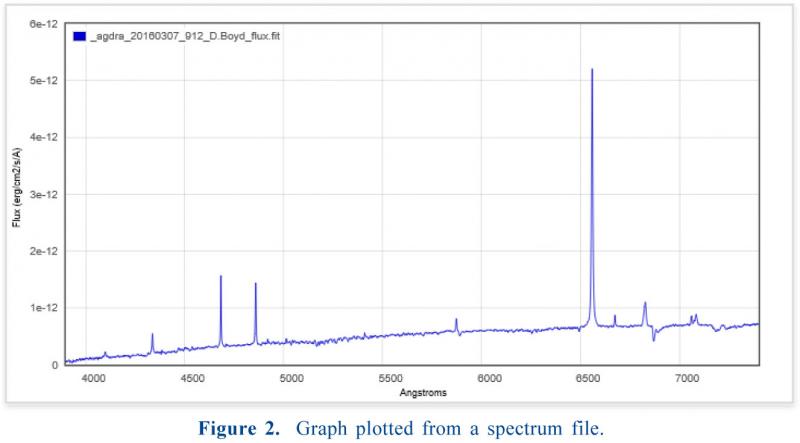Launch of the BAA spectroscopy database
2017 January 22
To cater for the recent increase in spectroscopic capability and interest within the amateur community, on 2016 November 15 the BAA launched an online spectroscopy database. The database is open for anyone to view and download spectra, while to upload spectra you will require a dedicated login. Requests for logins should be sent to the database manager [vssdbm@britastro.org] along with a sample 1D FITS file containing your observing location and equipment details.
 To access the spectra simply click on the ‘Review Spectra’ link on the spectroscopy database homepage (https://britastro.org/specdb/). This will take you to a screen (Figure 1) where you can select various parameters including the object name and a date range before requesting a list of the spectra contained within the database. You may then either plot the spectrum as a graph (Figure 2), or download the FITS data files.
To access the spectra simply click on the ‘Review Spectra’ link on the spectroscopy database homepage (https://britastro.org/specdb/). This will take you to a screen (Figure 1) where you can select various parameters including the object name and a date range before requesting a list of the spectra contained within the database. You may then either plot the spectrum as a graph (Figure 2), or download the FITS data files.
The decision to create a BAA database took careful consideration as there are already several spectroscopy databases in existence, for example the BeSS,1 ARAS2 and SASER3 databases. It was decided go ahead with a BAA database as we wanted a secure and robust repository which would accept spectra of any type of object, enable observers to upload their spectra easily, and let access to the spectra be open to all. Open access is important as it makes the spectra available to both the amateur and professional astronomical communities without placing obstacles in the way. It should be noted that although the spectra are freely available, both the individual observers and the BAA should be acknowledged in any publications where the spectra are used.
For spectra to be admitted into the database, they must be in 1D FITS file format that is compliant with the BeSS standard.4 This combined format is familiar to experienced astronomical spectroscopists, and is part of the learning process for those who are new to the field. There is no need to understand the full detail of the FITS file format or the BeSS standard as many of the spectroscopy software packages used by amateurs produce 1D BeSS compliant FITS files. A number of free software packages can produce this format and the database has been tested with FITS files produced by ISIS,5 BASS6 and VSpec.7
FITS is a standard format for storing astronomical data, standing for ‘Flexible Image Transport System’. Amateur imagers will be familiar with the format as it is commonly used to store 2D images. Spectra are stored in a 1D format as the spectrum is a 1-dimensional line of intensity values by wavelength. The BeSS standard4 defines keywords that must also be contained within the FITS file header, providing information on the object, the equipment and the observer.
To generate a compliant spectrum a set of images using a CCD camera connected to a spectrograph are obtained. This process has similarities to other astronomical imaging techniques, in particular photometry. It is necessary to take images of the target object spectrum, calibration lamp spectrum, bias frames, dark frames, flat field images and the spectrum of a reference star. The software package will then use these images to generate a graph of the spectrum and a 1D FITS file. Though not a requirement for the database, some observers take additional steps to flux-calibrate their spectra, so that the intensity is calibrated in units of the energy per unit area per wavelength received from the object.
At the end of 2016, 613 spectra had been uploaded to the database. Though many of the spectra are of stars such as novae, supernovae and other types of variable star, there are also spectra of comets, planets, galaxies and nebulae.
The database may be accessed by following the link on the BAA homepage (under Observations) or by typing the web address (above) into your computer’s web browser. It is hoped that this new database will prove to be a valuable resource to both BAA members and the wider astronomical community in the coming years.
Andrew Wilson, Manager, BAA Spectroscopy Database
References & links
1 BeSS, Be Star Spectra, http://basebe.obspm.fr/basebe/Accueil.php
2 ARAS, Astronomical Ring for Access to Spectroscopy, http://www.astrosurf.com/aras/Aras_DataBase/DataBase.htm
3 SASER, the Southern Astro Spectroscopy Email Ring, http://saser.wholemeal.co.nz/
4 BeSS standard, http://basebe.obspm.fr/basebe/Spec_spectres_BeSS_en.pdf
5 ISIS, Integrated Spectrographic Innovative Software, http://www.astrosurf.com/buil/isis/isis_en.htm
6 BASS, Basic Astronomical Spectroscopy Software, available from links section of the BASS Yahoo Group https://uk.groups.yahoo.com/neo/groups/astrobodger/info
7 VSpec, Visual Spec, http://www.astrosurf.com/vdesnoux/
| The British Astronomical Association supports amateur astronomers around the UK and the rest of the world. Find out more about the BAA or join us. |
